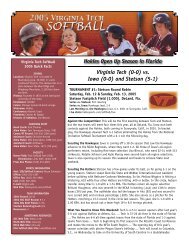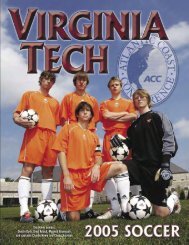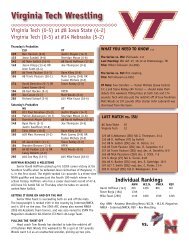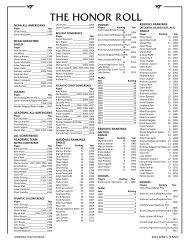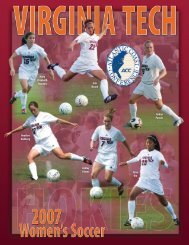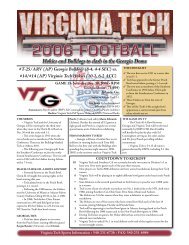Deron Washington AD Vassallo Coach Seth Greenberg - HokieSports
Deron Washington AD Vassallo Coach Seth Greenberg - HokieSports
Deron Washington AD Vassallo Coach Seth Greenberg - HokieSports
Create successful ePaper yourself
Turn your PDF publications into a flip-book with our unique Google optimized e-Paper software.
A History<br />
The Atlantic Coast Conference was founded<br />
on May 8, 1953, at the Sedgefield Inn near<br />
Greensboro, N.C., with seven charter members -<br />
Clemson, Duke, Maryland, North Carolina, North<br />
Carolina State, South Carolina and Wake Forest<br />
- drawing up the conference by-laws.<br />
The withdrawal of seven schools from<br />
the Southern Conference came early on the<br />
morning of May 8, 1953, during the Southern<br />
Conference’s annual spring meeting. On June<br />
14, 1953, the seven members met in Raleigh,<br />
N.C., where a set of bylaws was adopted and<br />
the name became officially the Atlantic Coast<br />
Conference.<br />
Suggestions from fans for the name of<br />
the new conference appeared in the region’s<br />
newspapers prior to the meeting in Raleigh.<br />
Some of the names suggested were: Dixie,<br />
Mid South, Mid Atlantic, East Coast, Seaboard,<br />
Colonial, Tobacco, Blue-Gray, Piedmont,<br />
Southern Seven and the Shoreline.<br />
Duke’s Eddie Cameron recommended that<br />
the name of the conference be the Atlantic<br />
Coast Conference, and the motion was passed<br />
unanimously. The meeting concluded with each<br />
member institution assessed $200.00 to pay for<br />
conference expenses.<br />
On December 4, 1953, conference officials<br />
met again at Sedgefield and officially admitted<br />
the University of Virginia as the league’s eighth<br />
member. The first, and only, withdrawal of a<br />
school from the ACC came on June 30, 1971,<br />
when the University of South Carolina tendered<br />
its resignation.<br />
The ACC operated with seven members<br />
until April 3, 1978, when the Georgia Institute<br />
of Technology was admitted. The Atlanta<br />
school had withdrawn from the Southeastern<br />
Conference in January of 1964.<br />
The ACC expanded to nine members on<br />
July 1, 1991, with the addition of Florida State<br />
University.<br />
The conference expanded to 11 members<br />
on July 1, 2004, with the addition of the<br />
University of Miami and Virginia Polytechnic<br />
Institute and State University. On October 17,<br />
2003, Boston College accepted an invitation to<br />
become the league’s 12th member starting with<br />
the 2005-06 academic year.<br />
The Schools<br />
Boston College was founded in 1863 by the<br />
Society of Jesus to serve the sons of Boston’s<br />
Irish immigrants and was the first institution of<br />
higher education to be founded in the city of<br />
Boston. Originally located on Harrison Avenue<br />
in the South End of Boston, the College outgrew<br />
its urban setting toward the end of its first fifty<br />
years. A new location was selected in Chestnut<br />
Hill and ground for the new campus was broken<br />
on June 19, 1909. During the 1940s, new<br />
purchases doubled the size of the main campus.<br />
In 1974, Boston College acquired Newton<br />
College of the Sacred Heart, 1.5 miles away. With<br />
15 buildings on 40 acres, it is now the site of the<br />
Law School and residence halls.<br />
Clemson University is nestled in the foothills<br />
of the Blue Ridge Mountains near the Georgia<br />
border, and the tiger paws painted on the<br />
roads make the return to I-85 easier. The school<br />
is built around Fort Hill, the plantation home<br />
of John C. Calhoun, Vice President to Andrew<br />
Jackson. His son-in-law, Tom Clemson, left the<br />
land to be used as an agricultural school, and in<br />
1893 Clemson opened its doors as a land-grant<br />
school, thanks to the efforts of Ben Tillman.<br />
Duke University was founded in 1924 by<br />
tobacco magnate James B. Duke as a memorial<br />
to his father, <strong>Washington</strong> Duke. Originally the<br />
school was called Trinity College, a Methodist<br />
institution, started in 1859. In 1892, Trinity<br />
moved to west Durham where the east campus<br />
with its Georgian architecture now stands.<br />
Nearby are Sarah P. Duke gardens, and further<br />
west the Gothic spires of Duke chapel overlook<br />
the west campus.<br />
Florida State University is one of 11<br />
universities of the State University System of<br />
Florida. It was established as the Seminary<br />
West of the Suwannee by an act of the<br />
Florida Legislature in 1851, and first offered<br />
instruction at the post-secondary level in 1857.<br />
Its Tallahassee campus has been the site of an<br />
institution of higher education longer than any<br />
other site in the state. In 1905, the Buckman Act<br />
reorganized higher education in the state and<br />
designated the Tallahassee school as the Florida<br />
Female College. In 1909, it was renamed Florida<br />
State College for Women. In 1947, the school<br />
returned to a co-educational status, and the<br />
name was changed to Florida State University.<br />
Next to I-85 in downtown Atlanta stands<br />
Georgia Institute of Technology, founded in<br />
1885. Its first students came to pursue a degree<br />
in mechanical engineering, the only one offered<br />
at the time. Tech’s strength is not only the<br />
red clay of Georgia, but a restored gold and<br />
white 1930 model A Ford Cabriolet, the official<br />
mascot. The old Ford was first used in 1961,<br />
but a Ramblin’ Wreck had been around for over<br />
three decades. The Ramblin’ Wreck fight song<br />
appeared almost as soon as the school opened,<br />
and it is not only American boys that grow up<br />
singing its rollicking tune, for Richard Nixon<br />
and Nikita Krushchev sang it when they met in<br />
Moscow in 1959.<br />
The University of Maryland opened in 1856<br />
as an agricultural school nine miles north of<br />
<strong>Washington</strong>, D.C., on land belonging to Charles<br />
Calvert, a descendant of Lord Baltimore, the<br />
state’s founding father. The school colors are the<br />
same as the state flag: black and gold for George<br />
Calvert (Lord Baltimore) and red and white<br />
for his mother, Alice Crossland. Maryland has<br />
been called the school that Curley Byrd built,<br />
for he was its quarterback, then football coach,<br />
athletic director, assistant to the president, vicepresident,<br />
and finally its president. Byrd also<br />
designed the football stadium and the campus<br />
layout, and suggested the nickname Terrapin,<br />
a local turtle known for its bite, when students<br />
wanted to replace the nickname Old Liners with<br />
a new one for the school.<br />
The University of Miami was chartered<br />
in 1925 by a group of citizens who felt an<br />
institution of higher learning was needed for<br />
the development of their young and growing<br />
community. Since the first class of 560 students<br />
enrolled in the fall of 1926, the University has<br />
expanded to more than 15,000 undergraduate<br />
and graduate students from every state and<br />
more than 114 nations from around the<br />
world. The school’s colors, representive of the<br />
Florida orange tree, were selected in 1926.<br />
Orange symbolizes the fruit of the tree, green<br />
represents the leaves and white, the blossoms.<br />
The University of North Carolina, located<br />
in Chapel Hill, has been called “the perfect<br />
college town,” making its tree-lined streets<br />
and balmy atmosphere what a college should<br />
look and feel like. Its inception in 1795 makes it<br />
one of the oldest schools in the nation, and its<br />
nickname of Tar Heels stems from the tar pitch<br />
and turpentine that were the state’s principal<br />
industry. The nickname is as old as the school,<br />
for it was born during the Revolutionary War<br />
when tar was dumped into the streams to<br />
impede the advance of British forces.<br />
North Carolina State University is located in<br />
the state capital of Raleigh. It opened in 1889 as<br />
a land-grant agricultural and mechanical school<br />
and was known as A&M or Aggies or Farmers<br />
for over a quarter-century. The school’s colors<br />
of pink and blue were gone by 1895, brown and<br />
white were tried for a year, but the students<br />
finally chose red and white to represent the<br />
school. An unhappy fan in 1922 said State<br />
football players behaved like a pack of wolves,<br />
and the term that was coined in derision<br />
became a badge of honor.<br />
The University of Virginia was founded in<br />
1819 by Thomas Jefferson and is one of three<br />
things on his tombstone for which he wanted<br />
to be remembered. James Madison and James<br />
Monroe were on the board of governors in the<br />
early years. The Rotunda, a half-scale version of<br />
the Pantheon which faces the Lawn, is the focal<br />
point of the grounds as the campus is called.<br />
Jefferson wanted his school to educate leaders<br />
in practical affairs and public service, not just to<br />
train teachers.<br />
Virginia Tech was established in 1872<br />
as an all-male military school dedicated to<br />
the original land-grant mission of teaching<br />
agriculture and engineering. The University has<br />
grown from a small college of 132 students into<br />
the largest institution of higher education in<br />
the state during its 132-year history. Located<br />
in Southwest Virginia on a plateau between<br />
the Blue Ridge and Alleghany Mountains, the<br />
campus consists of 334 buildings and 20 miles<br />
of sidewalks over 2,600 acres. The official school<br />
colors - Chicago maroon and burnt orange -<br />
were selected in 1896 because they made a<br />
“unique combination” not worn elsewhere at<br />
the time.<br />
Wake Forest University was started on<br />
Calvin Jones’ plantation amid the stately pine<br />
forest of Wake County in 1834. The Baptist<br />
seminary is still there, but the school was<br />
moved to Winston-Salem in 1956 on a site<br />
donated by Charles H. and Mary Reynolds<br />
Babcock. President Harry S. Truman attended<br />
the ground-breaking ceremonies that brought<br />
a picturesque campus of Georgian architecture<br />
and painted roofs. Wake’s colors have been<br />
black and gold since 1895, thanks to a badge<br />
designed by student John Heck who died<br />
before he graduated.<br />
2 0 0 7 - 2 0 0 8 V I R G I N I A T E C H M E N’ S B A S K E T B A L L<br />
THE ATLANTIC COAST CONFERENCE<br />
71






